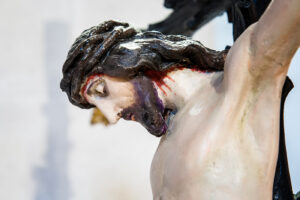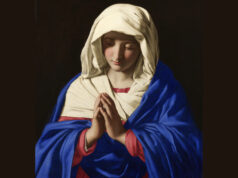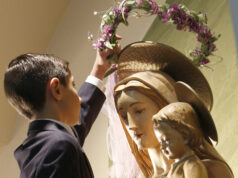Q: I have a friend who observed that some crucifixes depict the Savior with his eyes open and some depict him with his eyes closed. He wants to know which is correct — alive or dead? (Lakeland, Fla.)
A: With respect to the second part of your question, I think it’s equally correct for a crucifix to portray Jesus either as still alive on the cross or as just having died. The crucifixion was a progressive event in time, not one static snapshot, so it would be reasonable for an artist to choose to portray any number of given points of this part of Jesus’ passion.
As a parallel, we might think of artistic depictions of the Stations of the Cross: The second station, where Jesus is just taking up his cross, is not any more “correct” than the 14th station, when he is laid in the tomb, despite Jesus being alive in one and already dead in the other.
Considering the broader question of why Jesus’ eyes are open on some crucifixes and closed in others, it occurs to me that a crucifix with Jesus’ eyes closed might not necessarily be intended to show him as having already died. That is, it could be that an eyes-closed crucifix is meant rather to show the intensity of Jesus’ agony.
As far as I can tell, closed eyes on a crucifix does not indicate any specific symbolism on its own, unlike other symbols in Western Christian art that do have a specific meaning. For example, when Our Lady is shown with a white lily, this is understood as a reference to her purity and sinlessness. But the eyes of a crucifix might tell us something about the period in which the artist was working, or the style a modern artist was trying to emulate.

In the church’s first few centuries, crucifixes were not a common symbol at all. It seems that for the early Christians, crucifixion imagery was a bit too jarring — which makes sense when you consider that the early Christians would have known crucifixion as a grisly contemporary method of execution. In early Christian art, it is much more common to see Christ portrayed as the Good Shepherd, or for Christianity to be referenced via other more abstract symbols, such as a fish.
We start seeing more crucifixes around the time of the early Middle Ages, when Christianity became the dominant religion in Europe and parts of the Middle East, and when Christians likely had more of a sense of distance from the brutality of the Roman Empire. But even in this period, crucifixes tended to show Christ as a victorious king. Often in these crucifixes, Jesus’ expression is serene and untroubled, with his eyes wide open and staring ahead.
While this early medieval style of crucifix does express some real truths of our faith — Jesus was indeed victorious on the cross, and he never ceased to trust God his Father — these depictions can tend to engage the intellect more than the emotions.
This is not the case for later crucifixes, especially from what we call the “Counter-Reformation” period in the late 1500s. Alongside trends in Western art in general, these crucifixes often show Jesus in a very lifelike, naturalistic way, where his suffering is depicted in realistic and often graphic detail. The goal of this style was to touch the heart of its viewers, to help move their souls to greater love of the suffering Christ and to greater sorrow for their sins. This makes sense for this period in church history, as this was a time when the church — often though saints such as Teresa of Avila, John of the Cross, and Ignatius of Loyola — was calling the faithful to a greater spirit of penance and a more personal engagement in prayer after some of the abuses that occurred in the medieval period.
Jenna Marie Cooper, who holds a licentiate in canon law, is a consecrated virgin and a canonist whose column appears weekly at OSV News. Send your questions to CatholicQA@osv.com.







